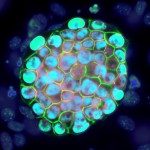Link to Pubmed [PMID] – 11683170
Cell Tissue Res. 2001 Oct;306(1):1-14
Interstitial cells of Cajal (ICC) are important regulatory cells in the smooth muscle coats of the digestive tract. Expression of the Kit receptor tyrosine kinase was used in this study as a marker to study their distribution and development in the striated musculature of the mouse esophagus. Sections and whole-mounts were studied by immunohistochemistry. KitW-lacZ transgenic mice, which carry the lacZ reporter gene inserted in place of the first exon of the Kit gene, were processed for Xgal histochemistry, for quantitative analysis and for ultrastructural studies. Spindle-shaped ICC were scarce in both muscle layers of the thoracic esophagus, while their number increased steeply toward the cardia in the striated portion of the intraabdominal esophagus. They did not form networks and had no relationship with intrinsic myenteric ganglia and motor end-plates. They were often close to nerve fibers immunoreactive for neuronal nitric oxide synthase (nNOS), vasoactive intestinal polypeptide (VIP) or neuropeptide Y (NPY), but not to fibers immunoreactive for substance P (SP), calcitonin gene related peptide (CGRP), enkephalin, or the capsaicin receptor VRI. They were present in the fetus but absent in adult ICC-deficient KitW-lacZ/KitWv mice. Interstitial cells of Cajal were identified by electron microscopy by their ultrastructure in the striated muscle of the esophagus and exhibited Xgal labeling, while fibroblasts and muscle cells were unlabeled. Interstitial cells of Cajal are scattered between striated muscle cells in the mouse esophagus. They are close to nerves with defined neurochemical coding and could possibly represent specialized esophageal spindle proprioceptors.

